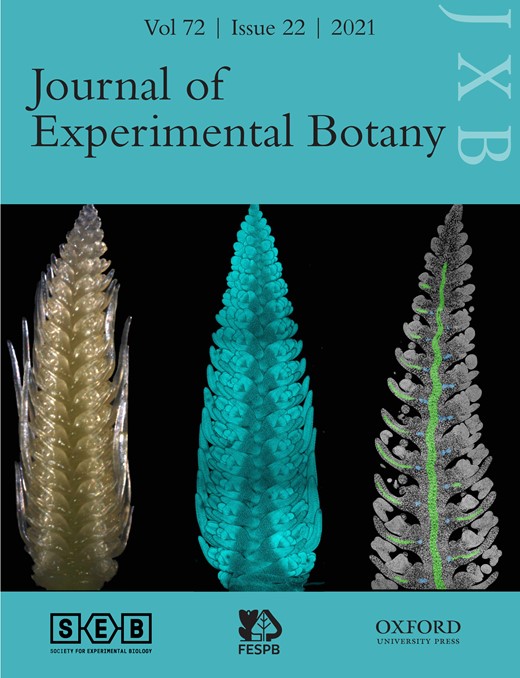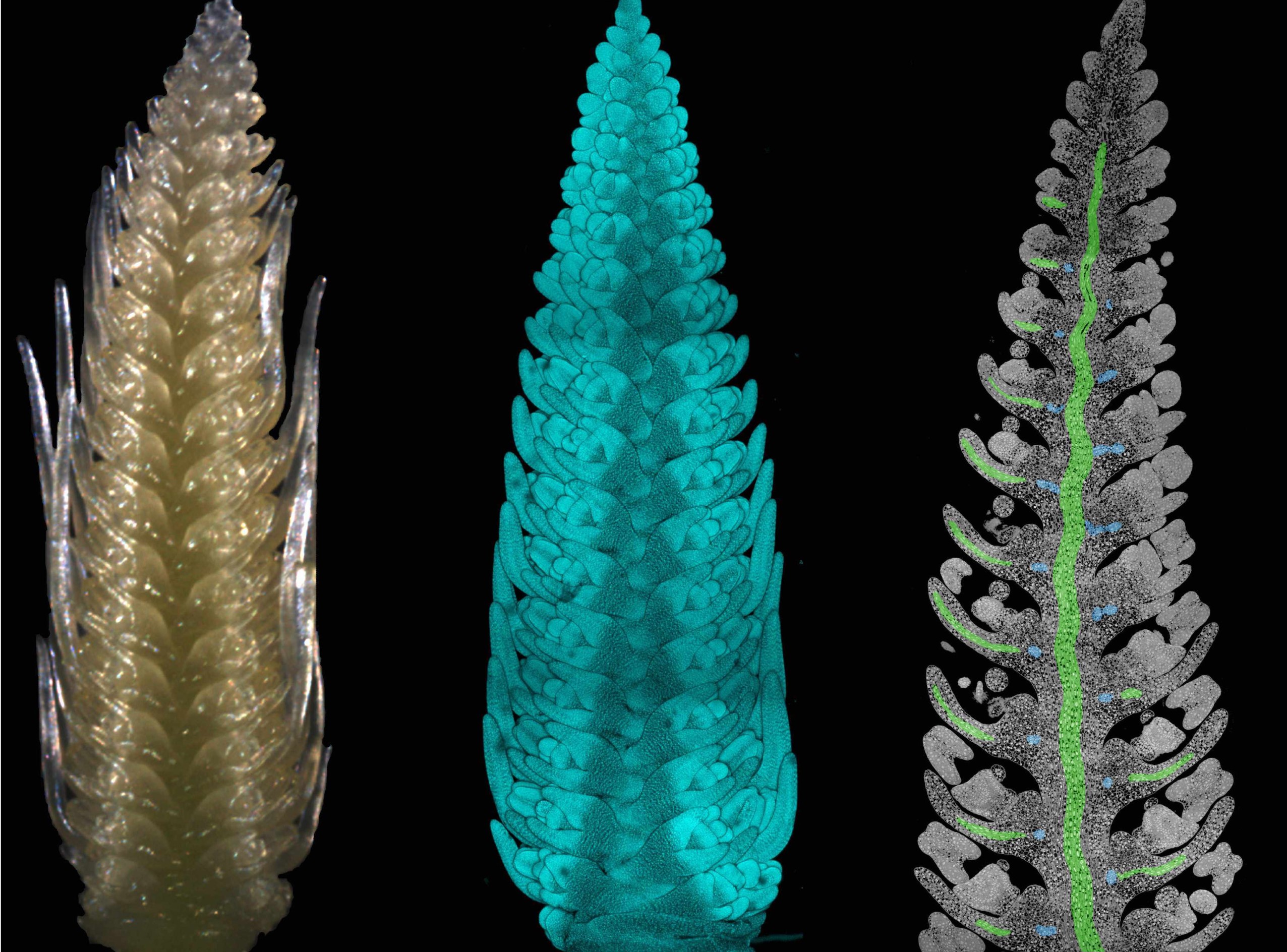
Cover image

Volume 72, Issue 22, 4 December 2021
eXtra Botany
Insights
Small molecules mediate cellular reprogramming across two kingdoms
This article comments on:
Berenguer E, Carneros E, Pérez-Pérez Y, Gil C, Martínez A, Testillano PS. 2021. Small molecule inhibitors of mammalian GSK-3β promote in vitro plant cell reprogramming and somatic embryogenesis in crop and forest species. Journal of Experimental Botany 72, 7808–7825.
A poplar option: the ‘within-individual approach’ for elucidating xylem structure–function relationships
This article comments on:
Baer AB, Fickle JC, Medina J, Robles C, Pratt RB, Jacobsen AL. 2021. Xylem biomechanics, water storage, and density within roots and shoots of an angiosperm tree species. Journal of Experimental Botany 72, 7984–7997.
Viewpoint
Whither metabolic flux analysis in plants?
EXPERT VIEW
Autophagy in sexual plant reproduction: new insights
Recent advances in the study of autophagy highlight its critical roles in sexual plant reproduction and several fundamental questions worthy of investigation in the future.
REVIEW PAPERS
From crops to shops: how agriculture can use circadian clocks
Circadian agriculture can increase productivity and sustainability. Plant growth and development can be manipulated, and resources can be optimized, if abiotic and biotic rhythms are considered.
Chlamydomonas proteases: classification, phylogeny, and molecular mechanisms
Proteases are catabolic or processing enzymes cleaving peptide bonds. Chlamydomonas reinhardtii exhibits reduced complexity of many protease families, representing a tractable model for studying these vital but poorly understood enzymes.
RESEARCH PAPERS
Crop Molecular Genetics
Morphometric relationships and their contribution to biomass and cannabinoid yield in hybrids of hemp (Cannabis sativa)
Stem and canopy architecture traits are superior predictors of floral biomass yield and offer a good indication of hybrid uniformity in field plantings of genetically diverse cannabinoid hemp populations.
Delaying or delivering: identification of novel NAM-1 alleles that delay senescence to extend wheat grain fill duration
Two staygreen mutants were identified for which grain fill duration and grain weight were enhanced. Independent amino acid substitutions within NAC subdomain IV of NAM-1 homoeologues are proposed as causative.
Confirmation of GmPPR576 as a fertility restorer gene of cytoplasmic male sterility in soybean
We confirmed GmPPR576 as a fertility restorer gene of soybean CMS line NJCMS1A, which will enable more efficient use of heterosis and potentially bring about a green revolution in soybean farming.
Growth and Development
‘Spikelet stop’ determines the maximum yield potential stage in barley
The barley maximum yield potential (MYP) stage can differ from the awn primordium stage and varies depending on the genotype and growth conditions. We suggest key steps to identify MYP in barley that might apply to related cereals.
Strategies of grain number determination differentiate barley row types
Grain number in two-rowed barley spikes is predominantly determined by the potential spikelet number while in six-rowed barley is determined by spikelet survival.
Identification of a gene responsible for seedpod spine formation and other phenotypic alterations using whole-genome sequencing analysis in Medicago truncatula
A mutant with a suite of phenotypic changes, including seedpod spine formation, was recovered from tissue culture. The gene responsible was identified by whole-genome sequencing and bioinformatics analysis.
Three classes of hemoglobins are required for optimal vegetative and reproductive growth of Lotus japonicus: genetic and biochemical characterization of LjGlb2-1
Knockout mutants of Lotus japonicus demonstrate that three classes of phytoglobins are required for optimal vegetative and reproductive development. The most unusual hemoglobin LjGlb2-1 is genetically and biochemically characterized.
Identification of ZmNF-YC2 and its regulatory network for maize flowering time
ZmNF-YC2 was identified by map-based cloning and shown to positively regulate maize flowering time under long-day conditions. We developed a gene regulatory model of maize flowering time.
Small molecule inhibitors of mammalian GSK-3β promote in vitro plant cell reprogramming and somatic embryogenesis in crop and forest species
Inhibition of GSK-3 activity by novel small molecules enhances somatic embryogenesis efficiency by activating the brassinosteroid pathway, an innovation with high potential to improve in vitro plant regeneration for crop and forest breeding techniques.
OsbZIP62/OsFD7, a functional ortholog of FLOWERING LOCUS D, regulates floral transition and panicle development in rice
OsbZIP62/OsFD7 interacts with the major flowering regulators participating in the processes of floral transition as well as panicle and floral organ development.
Photosynthesis and Metabolism
Analyzing the causes of method-to-method variability among Rubisco kinetic traits: from the first to the current measurements
This study highlights the methodological causes responsible for the intraspecific variability among Rubisco kinetic traits and provides a normalized kinetic dataset for model species to be used by the scientific community.
Dynamic changes in cell wall composition of mature sunflower leaves under distinct water regimes affect photosynthesis
Changes in cell wall composition of mature H. annuus leaves differentially affect photosynthesis during gradual short-term water deficit stress and dynamic recovery after long-term water deficit stress.
The C4 cycle and beyond: diverse metabolic adaptations accompany dual-cell photosynthetic functions in Setaria
Proteomic and kinetic analyses disclose metabolic strategies involving chloroplastic, mitochondrial, and peroxisomal proteins to maintain an optimal performance of the C4 cycle.
Plant—Environment Interactions
The BTB/POZ domain protein GmBTB/POZ promotes the ubiquitination and degradation of the soybean AP2/ERF-like transcription factor GmAP2 to regulate the defense response to Phytophthora sojae
Soybean GmBTB/POZ interacts directly with GmAP2 and promotes its ubiquitination and degradation, which releases its suppression of GmWRKY33 and thereby increases the defense response to Phytophthora sojae.
Root infection by the nematode Meloidogyne incognita modulates leaf antiherbivore defenses and plant resistance to Spodoptera exigua
The impact of root infection by the nematode Meloidogyne incognita on leaf anti-herbivore defenses and plant resistance to the caterpillar Spodoptera exigua is modulated by the nematode infection cycle.
Chromatin accessibility landscapes activated by cell-surface and intracellular immune receptors
Effective plant immunity requires activation of both cell-surface and intracellular receptors, which increases chromatin accessibility at induced defence genes, under the control of both conserved and unique transcriptional regulatory mechanisms.
Systemic control of nodule formation by plant nitrogen demand requires autoregulation-dependent and independent mechanisms
Systemic control of the plant N demand on transcriptome reprogramming associated with establishment of rhizobial symbiosis involves the SUNN/CLE and additional pathways.
Anatomies, vascular architectures, and mechanics underlying the leaf size-stem size spectrum in 42 Neotropical tree species
Water supply and mechanical stability remain proportional to shoot leaf area due to allometric scaling of vessel diameter and stem length with shoot size across 42 neotropical tree species.
Characterization of growth and development of sorghum genotypes with differential susceptibility to Striga hermonthica
Model sorghum varieties for resistance or susceptiblity to the parasitic weed Striga hermonthica differ in growth, development, root system architecture, hormone abundance, and metabolic gene expression.
Xylem biomechanics, water storage, and density within roots and shoots of an angiosperm tree species
Xylem biomechanics and water storage differ greatly between woody roots and stems within an angiosperm tree species, with roots having greater water storage and reduced biomechanical support relative to stems.


